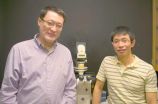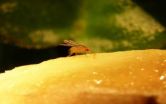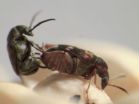(Press-News.org) Bethesda, MD—When astronauts return to Earth, their altitude isn't the only thing that drops—their blood pressure does too. This condition, known as orthostatic hypotension, occurs in up to half of those astronauts on short-term missions (two weeks or less) and in nearly all astronauts after long-term missions (four to six months). A new research report published online in The FASEB Journal (http://www.fasebj.org) solves the biological mystery of how this happens by showing that low gravity compromises the ability of arteries and veins to constrict normally, inhibiting the proper flow of blood. Prevention and treatment strategies developed for astronauts may also hold promise for elderly populations on Earth who experience orthostatic hypotension more than any other age group.
"The idea of space exploration has been tantalizing the imagination of humans since our early existence. As a scientist, I have had the opportunity to learn that there are many medical challenges associated with travel in a weightless environment, such as orthostatic hypotension, bone loss and the recently recognized visual impairment that occurs in astronauts," said Michael D. Delp, Ph.D., a researcher involved in the work from the Department of Applied Physiology and Kinesiology, and the Center for Exercise Science at the University of Florida in Gainesville, Florida. "Although I have come to realize that it is unlikely I will ever get to fulfill my childhood dream of flying in space, I take great satisfaction with helping in the discovery of how microgravity alters the human body and how we can minimize these effects, so humans can safely explore the bounds of our universe."
To make this discovery, Delp and colleagues examined arteries and veins from mice housed at Kennedy Space Center in Florida with blood vessels from groups of mice flown on three of the last five space shuttle missions—STS-131, STS-133 and STS-135. Mice flown on the STS-131 and STS-135 missions were tested immediately after returning to Earth, whereas mice from STS-133 were tested one, five and seven days after landing. Not only did they find that these mice experienced the equivalent of orthostatic hypotension in humans, they also discovered that it takes as many as four days in normal gravity before the condition is reversed.
"There has been considerable interest in sending humans to the moon, asteroids, and Mars," said Gerald Weissmann, M.D., Editor-in-Chief of The FASEB Journal, "but what we're finding is that extended space missions have their own inherent risks above and beyond the obvious. If we ever hope to visit distant worlds for extended periods of time—or colonize them permanently—we've got to figure out how to mitigate the effects that low and no gravity has on the body. This report brings us an important step closer to doing just that."
### Receive monthly highlights from The FASEB Journal by e-mail. Sign up at http://www.faseb.org/fjupdate.aspx. The FASEB Journal (http://www.fasebj.org) is published by the Federation of the American Societies for Experimental Biology (FASEB). It is among the most cited biology journals worldwide according to the Institute for Scientific Information and has been recognized by the Special Libraries Association as one of the top 100 most influential biomedical journals of the past century. FASEB is composed of 26 societies with more than 100,000 members, making it the largest coalition of biomedical research associations in the United States. Celebrating 100 Years of Advancing the Life Sciences in 2012, FASEB is rededicating its efforts to advance health and well-being by promoting progress and education in biological and biomedical sciences through service to our member societies and collaborative advocacy.
Details: Bradley J. Behnke, John N. Stabley, Danielle J. McCullough, Robert T. Davis III, James M.
Dominguez II, Judy M. Muller-Delp, and Michael D. Delp. Effects of spaceflight and ground recovery on mesenteric artery and vein constrictor properties in mice. FASEB J doi:10.1096/fj.12-218503 ; http://www.fasebj.org/content/early/2012/10/24/fj.12-218503.abstract
Why astronauts experience low blood pressure after returning to Earth from space
New research in the FASEB Journal suggests that a major cause of low blood pressure during standing is the compromised ability of arteries and veins to constrict normally and return blood back to the heart
2012-10-25
ELSE PRESS RELEASES FROM THIS DATE:
Whitehead scientists identify major flaw in standard approach to global gene expression analysis
2012-10-25
CAMBRIDGE, Mass. (October 25, 2012) –Whitehead Institute researchers report that common assumptions employed in the generation and interpretation of data from global gene expression analyses can lead to seriously flawed conclusions about gene activity and cell behavior in a wide range of current biological research.
"Expression analysis is one of the most commonly used methods in modern biology," says Whitehead Member Richard Young. "So we are concerned that flawed assumptions may affect the interpretation of many biological studies."
Much of today's interpretation ...
A new technique to study how myeloids become white blood cells
2012-10-25
University of Illinois cell and developmental Biology professor Fei Wang and colleagues have created a new technique to study how myeloids, a type of blood stem cell, become the white blood cells important for immune system defense against infections and tissue damage. This approach offers new insights into the molecular mechanisms at work during myeloid differentiation, and may improve our ability to treat myeloid diseases like leukemia, the researchers report. Their findings appear in the journal Blood.
Myeloids are blood stem cells from bone marrow or the spinal cord ...
Results of the RESPECT trial presented at TCT 2012
2012-10-25
MIAMI, FL – OCTOBER 25, 2012 – A clinical trial indicates that using an investigational medical device to close a PFO, or "hole in the heart," may be superior to medical management alone in the prevention of a repeated stroke. Results of the RESPECT trial were presented today at the 24th annual Transcatheter Cardiovascular Therapeutics (TCT) scientific symposium. Sponsored by the Cardiovascular Research Foundation (CRF), TCT is the world's premier educational meeting specializing in interventional cardiovascular medicine.
A PFO (patent foramen ovale) is a flap-like opening ...
Results of the PC trial presented at TCT 2012
2012-10-25
MIAMI, FL – OCTOBER 25, 2012 – A clinical trial that compared catheter-based PFO closure using an investigational device found that there was no significant reduction in ischemic and bleeding events compared to standard medical therapy; stroke risk was non-significantly reduced with device therapy. The PC Trial was presented at the 24th annual Transcatheter Cardiovascular Therapeutics (TCT) scientific symposium. Sponsored by the Cardiovascular Research Foundation (CRF), TCT is the world's premier educational meeting specializing in interventional cardiovascular medicine. ...
University of Toronto study demonstrates impact of adversity on early life development
2012-10-25
TORONTO, ON – It is time to put the nature versus nurture debate to rest and embrace growing evidence that it is the interaction between biology and environment in early life that influences human development, according to a series of studies recently published in a special edition of the Proceedings of the National Academy of Sciences (PNAS).
"Biologists used to think that our differences are pre-programmed in our genes, while psychologists argued that babies are born with a blank slate and their experience writes on it to shape them into the adults they become. Instead, ...
For the Milky Way, it's snack time
2012-10-25
Using the Sloan Digital Sky Survey, researchers have discovered a band, or stream, of stars believed to be the remnant of an ancient star cluster slowly being ingested by the Milky Way, Earth's home galaxy.
"The Milky Way is constantly gobbling up small galaxies and star clusters," said Ana Bonaca, a Yale graduate student and lead author of a study forthcoming in Astrophysical Journal Letters. "The more powerful gravity of our Milky Way pulls these objects apart and their stars then become part of the Milky Way itself."
Researchers have previously found evidence of ...
Far from random, evolution follows a predictable genetic pattern, Princeton researchers find
2012-10-25
Evolution, often perceived as a series of random changes, might in fact be driven by a simple and repeated genetic solution to an environmental pressure that a broad range of specieshappen to share, according to new research.
Princeton University research published in the journal Science suggests that knowledge of a species' genes — and how certain external conditions affect the proteins encoded by those genes — could be used to determine a predictable evolutionary pattern driven by outside factors. Scientists could then pinpoint how the diversity of adaptations seen ...
Size does matter in sexual selection, at least among beetles
2012-10-25
A new collaborative project among researchers from Uppsala University in Sweden and the University of Cincinnati has, for the first time, demonstrated experimentally the evolutionary force behind the rapid evolution of male genitals, focusing on a species of seed beetle.
This mechanism is revealed in a study published today in the scientific journal Current Biology. The experiments leading to this paper involved a species of seed beetle known as Callosobruchus maculatus. Mating among these beetles involves several males engaging in copulation with individual females. ...
Results of the POSEIDON trial presented at TCT 2012
2012-10-25
MIAMI, FL – OCTOBER 25, 2012 – A hydration regimen tailored to the patient's fluid status was effective in reducing damage to kidneys in patients undergoing cardiac catheterization, according to a study presented at the 24th annual Transcatheter Cardiovascular Therapeutics (TCT) scientific symposium, sponsored by the Cardiovascular Research Foundation. TCT is the world's premier educational meeting specializing in interventional cardiovascular medicine.
Contrast-induced acute kidney injury (CI-AKI), or contrast-induced nephropathy, refers to kidney damage that may occur ...
1-year results of ADAPT-DES presented at TCT 2012
2012-10-25
MIAMI, FL – OCTOBER 25, 2012 – Patients who receive a drug-eluting stent (DES) and demonstrate low levels of platelet inhibition are more likely to have blood clots form on the stent and suffer a possible heart attack; conversely, patients with higher levels of platelet inhibition are at greater risk for bleeding complications. One-year results of the ADAPT-DES study were presented today at the 24th annual Transcatheter Cardiovascular Therapeutics (TCT) scientific symposium. Sponsored by the Cardiovascular Research Foundation, TCT is the world's premier educational meeting ...
LAST 30 PRESS RELEASES:
Scientists ID potential way to prevent brain injuries from triggering Alzheimer's
MASTER 2nd Open Call: Execution period kick-off
Algae for health in food and pharma
Advanced microrobots driven by acoustic and magnetic fields for biomedical applications
Chicago health information leader recognized for raising CPR readiness and blood pressure awareness
The Intimate Animal, a new book from Kinsey Institute Executive Director Dr. Justin Garcia
When blue-collar workers lose union protection, they try self-employment
New video dataset to advance AI for health care
MEA-based graph deviation network for early autism syndrome signatures in human forebrain organoids
New modeling approach sheds light on rare gut disease
Study documents potentially hazardous flame retardants in firefighter gear
Can certain bacteria regulate aging of the immune system and its related alterations?
AI model helps diagnose often undetected heart disease from simple EKG
There are fewer online trolls than people think
Cell membrane fluctuations produce electricity
Jeonbuk National University study shows positive parenting can protect adolescents against self-harm
Surface-engineered ZnO nanocrystals to tackle perfluoroalkyl substance contamination
This new understanding of T cell receptors may improve cancer immunotherapies
A new fossil face sheds light on early migrations of ancient human ancestor
A new immunotherapy approach could work for many types of cancer
A new way to diagnose deadly lung infections and save lives
40 percent of MRI signals do not correspond to actual brain activity
How brain-inspired algorithms could drive down AI energy costs
Gum disease may be linked to plaque buildup in arteries, higher risk of major CVD events
Contrails are a major driver of aviation’s climate impact
Structure of dopamine-releasing neurons relates to the type of circuits they form for smell-processing
Reducing social isolation protects the brain in later life
Keeping the heart healthy increases longevity even after cancer
Young adults commonly mix cannabis with nicotine and tobacco
Comprehensive review illuminates tau protein's dual nature in brain health, disease, and emerging psychiatric connections
[Press-News.org] Why astronauts experience low blood pressure after returning to Earth from spaceNew research in the FASEB Journal suggests that a major cause of low blood pressure during standing is the compromised ability of arteries and veins to constrict normally and return blood back to the heart


